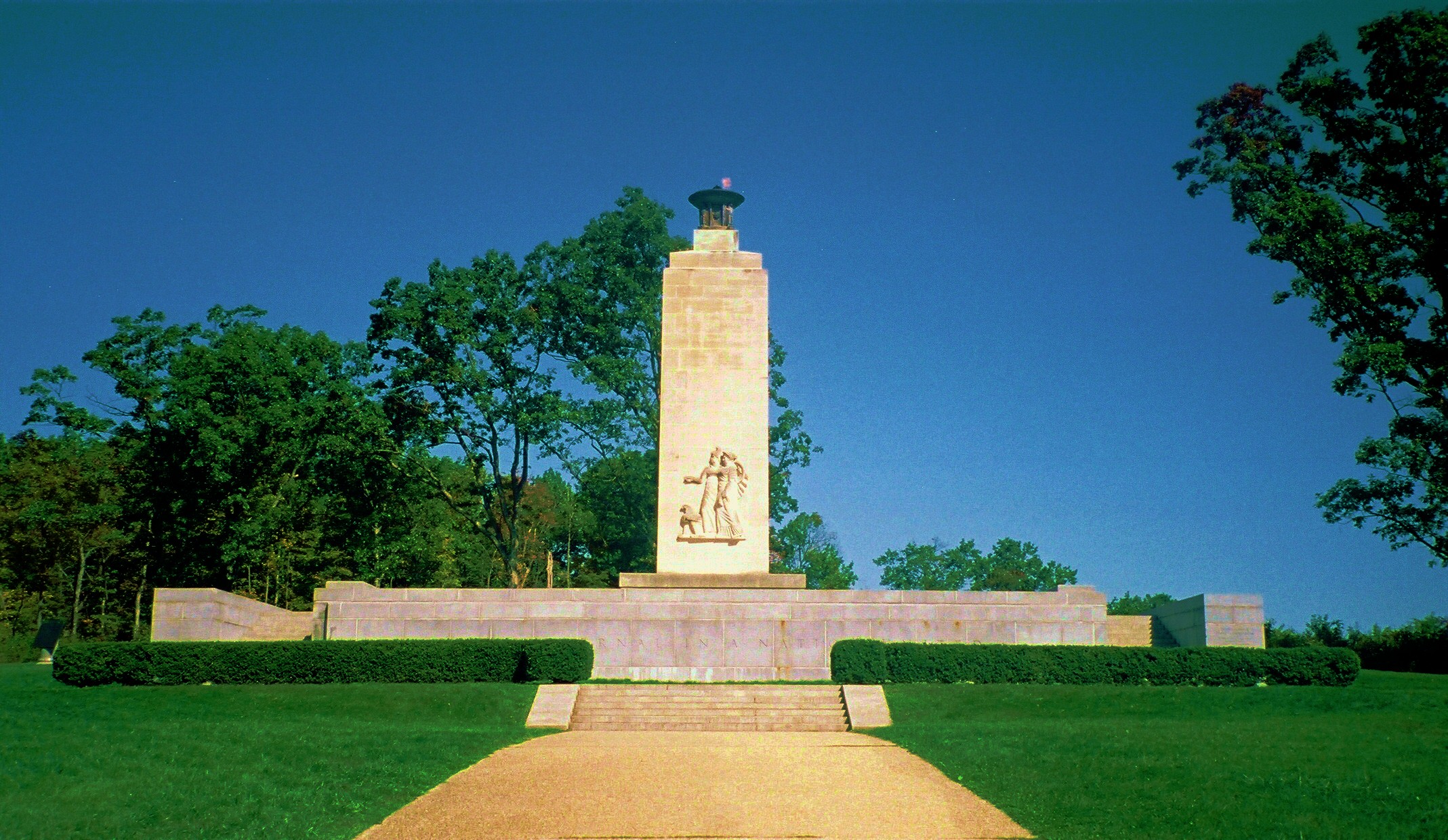|
Hunter's Run And Slate Belt Railroad
The Hunter's Run and Slate Belt Railroad was a railway line from the Hunter's Run junction of the Gettysburg and Harrisburg Railway that ran southwestward along the south side of Mountain Creek to the Pine Grove Iron Works. The line serviced facilities for mining (e.g., Henry Clay iron mine), for manufacturing (Crane's Siding clay refining plant), and for recreation (Pine Grove Park for excursions). Portions of the railbed are a section of the Appalachian Trail as well as the majority of the Cumberland County Biker/Hiker Trail and the entire "Old Railroad Bed Road" that is the southeast border of Pine Grove Furnace State Park. History The "Hunter's Run and Slate Belt R.R. Co." was incorporated on June 8, 1891, to build from Pine Grove Furnace to "Old Slate Quarry," in Adams County. The railway line leased the former South Mountain Railroad tracks between Hunters Run and Pine Grove Furnace from the South Mountain Railway and Mining Company on July 13, 1891. The extension to Sl ... [...More Info...] [...Related Items...] OR: [Wikipedia] [Google] [Baidu] |
Mountain Creek (Yellow Breeches Creek)
Mountain Creek is a U.S. Geological Survey. National Hydrography Dataset high-resolution flowline dataThe National Map accessed August 8, 2011 tributary of Yellow Breeches Creek in Cumberland County, Pennsylvania. Course Mountain Creek starts in the South Mountain Range and Michaux State Forest and flows through them and Pine Grove Furnace State Park. After leaving the state park, the stream runs through Toland and the Holly Gap Marsh Preserve. It flows through the borough of Mount Holly Springs and joins with Yellow Breeches Creek near the borough. Upper Mountain Creek is impounded by two dams to create mountain reservoirs, Laurel Lake and Fuller Lake. Tributaries * Hunters Run * Tagg Run * Sage Run * Iron Run * Toms Run Recreation Mountain Creek is a popular stocked trout stream, stocked with Brook, Brown, and Rainbow trout. In the headwaters and tributaries, there is a fair population of wild Brook Trout.flyfisherman.com See also *List of rivers of Pennsylvania Th ... [...More Info...] [...Related Items...] OR: [Wikipedia] [Google] [Baidu] |
South Mountain Railway And Mining Company
South is one of the cardinal directions or compass points. The direction is the opposite of north and is perpendicular to both east and west. Etymology The word ''south'' comes from Old English ''sūþ'', from earlier Proto-Germanic ''*sunþaz'' ("south"), possibly related to the same Proto-Indo-European root that the word ''sun'' derived from. Some languages describe south in the same way, from the fact that it is the direction of the sun at noon (in the Northern Hemisphere), like Latin meridies 'noon, south' (from medius 'middle' + dies 'day', cf English meridional), while others describe south as the right-hand side of the rising sun, like Biblical Hebrew תֵּימָן teiman 'south' from יָמִין yamin 'right', Aramaic תַּימנַא taymna from יָמִין yamin 'right' and Syriac ܬܰܝܡܢܳܐ taymna from ܝܰܡܝܺܢܳܐ yamina (hence the name of Yemen, the land to the south/right of the Levant). Navigation By convention, the ''bottom or down-facing side'' of a ... [...More Info...] [...Related Items...] OR: [Wikipedia] [Google] [Baidu] |
Railway Companies Disestablished In 1910
Rail transport (also known as train transport) is a means of transport that transfers passengers and goods on wheeled vehicles running on rails, which are incorporated in tracks. In contrast to road transport, where the vehicles run on a prepared flat surface, rail vehicles (rolling stock) are directionally guided by the tracks on which they run. Tracks usually consist of steel rails, installed on sleepers (ties) set in ballast, on which the rolling stock, usually fitted with metal wheels, moves. Other variations are also possible, such as "slab track", in which the rails are fastened to a concrete foundation resting on a prepared subsurface. Rolling stock in a rail transport system generally encounters lower frictional resistance than rubber-tyred road vehicles, so passenger and freight cars (carriages and wagons) can be coupled into longer trains. The operation is carried out by a railway company, providing transport between train stations or freight customer facilit ... [...More Info...] [...Related Items...] OR: [Wikipedia] [Google] [Baidu] |
Transportation In Cumberland County, Pennsylvania
Transport (in British English), or transportation (in American English), is the intentional movement of humans, animals, and goods from one location to another. Modes of transport include air, land (rail and road), water, cable, pipeline, and space. The field can be divided into infrastructure, vehicles, and operations. Transport enables human trade, which is essential for the development of civilizations. Transport infrastructure consists of both fixed installations, including roads, railways, airways, waterways, canals, and pipelines, and terminals such as airports, railway stations, bus stations, warehouses, trucking terminals, refueling depots (including fueling docks and fuel stations), and seaports. Terminals may be used both for interchange of passengers and cargo and for maintenance. Means of transport are any of the different kinds of transport facilities used to carry people or cargo. They may include vehicles, riding animals, and pack animals. Vehicles may inc ... [...More Info...] [...Related Items...] OR: [Wikipedia] [Google] [Baidu] |
South Mountain Range (Maryland−Pennsylvania)
South is one of the cardinal directions or compass points. The direction is the opposite of north and is perpendicular to both east and west. Etymology The word ''south'' comes from Old English ''sūþ'', from earlier Proto-Germanic ''*sunþaz'' ("south"), possibly related to the same Proto-Indo-European root that the word ''sun'' derived from. Some languages describe south in the same way, from the fact that it is the direction of the sun at noon (in the Northern Hemisphere), like Latin meridies 'noon, south' (from medius 'middle' + dies 'day', cf English meridional), while others describe south as the right-hand side of the rising sun, like Biblical Hebrew תֵּימָן teiman 'south' from יָמִין yamin 'right', Aramaic תַּימנַא taymna from יָמִין yamin 'right' and Syriac ܬܰܝܡܢܳܐ taymna from ܝܰܡܝܺܢܳܐ yamina (hence the name of Yemen, the land to the south/right of the Levant). Navigation By convention, the ''bottom or down-facing side'' of a ... [...More Info...] [...Related Items...] OR: [Wikipedia] [Google] [Baidu] |
History Of Cumberland County, Pennsylvania
History (derived ) is the systematic study and the documentation of the human activity. The time period of event before the invention of writing systems is considered prehistory. "History" is an umbrella term comprising past events as well as the memory, discovery, collection, organization, presentation, and interpretation of these events. Historians seek knowledge of the past using historical sources such as written documents, oral accounts, art and material artifacts, and ecological markers. History is not complete and still has debatable mysteries. History is also an academic discipline which uses narrative to describe, examine, question, and analyze past events, and investigate their patterns of cause and effect. Historians often debate which narrative best explains an event, as well as the significance of different causes and effects. Historians also debate the nature of history as an end in itself, as well as its usefulness to give perspective on the problems o ... [...More Info...] [...Related Items...] OR: [Wikipedia] [Google] [Baidu] |
Defunct Pennsylvania Railroads
Defunct (no longer in use or active) may refer to: * ''Defunct'' (video game), 2014 * Zombie process or defunct process, in Unix-like operating systems See also * * :Former entities * End-of-life product An end-of-life product (EOL product) is a product at the end of the product lifecycle which prevents users from receiving updates, indicating that the product is at the end of its useful life (from the vendor's point of view). At this stage, a ... * Obsolescence {{Disambiguation ... [...More Info...] [...Related Items...] OR: [Wikipedia] [Google] [Baidu] |
Slate Belt, Pennsylvania
Slate is a fine-grained, foliation (geology), foliated, homogeneous metamorphic rock derived from an original shale-type sedimentary rock composed of clay or volcano, volcanic ash (volcanic), ash through low-grade regional metamorphism. It is the finest grained foliated metamorphic rock. Foliation may not correspond to the original sedimentary layering, but instead is in planes perpendicular to the direction of metamorphic compression. The foliation in slate is called "slaty cleavage". It is caused by strong compression causing fine grained clay flakes to regrow in planes perpendicular to the compression. When expertly "cut" by striking parallel to the foliation, with a specialized tool in the quarry, many slates will display a property called fissility (geology), fissility, forming smooth flat sheets of stone which have long been used for roofing, floor tiles, and other purposes. Slate is frequently grey in color, especially when seen, en masse, covering roofs. However, slate o ... [...More Info...] [...Related Items...] OR: [Wikipedia] [Google] [Baidu] |
South Mountain Railroad (Cumberland)
The South Mountain Railroad was a southcentral Pennsylvania railway line for "connecting the Pine Grove works to the Cumberland Valley R. R." (Keefer also authore''Early Iron Industries of Dauphin County'')/ref> and which provided mining and passenger services via a southwest section from Hunter's Run, Pennsylvania, and a northern section from Hunter's Run to the CVRR junction northeast of Carlisle. The northern section merged with the Gettysburg & Harrisburg ''Railroad'' line south from Hunter's Run to the Gettysburg Battlefield in 1891 to create the Gettysburg & Harrisburg ''Railway'' line, while the branch southwest from Hunter's Run became the Hunter's Run and Slate Belt Railroad line. Modernized sections of the South Mountain Railroad remain north of Hunter's Run; while parts of the railbed are available for hiking and biking such as near Carlisle ( Letort Spring Run Nature Trail) and the Pine Grove Furnace State Park ( Cumberland County Biker/Hiker Trail with section of ... [...More Info...] [...Related Items...] OR: [Wikipedia] [Google] [Baidu] |
Hunter's Run, Pennsylvania
Hunters Run is a populated place in the South Mountain Range and Cumberland County, Pennsylvania. It is located where the Gettysburg and Harrisburg Railroad station was established in 1884, at the junction with the 1870 South Mountain Railroad. The junction was later the northeast endpoint of the namesake 1891 Hunter's Run and Slate Belt Railroad. References External links {{authority control Unincorporated communities in Cumberland County, Pennsylvania South Mountain Range (Maryland−Pennsylvania) Unincorporated communities in Pennsylvania ... [...More Info...] [...Related Items...] OR: [Wikipedia] [Google] [Baidu] |
Adams County, Pennsylvania
Adams County is a county in the Commonwealth of Pennsylvania. As of the 2020 census, the population was 103,852. Its county seat is Gettysburg. The county was created on January 22, 1800, from part of York County, and was named for the second President of the United States, John Adams. On July 1–3, 1863, a crucial battle of the American Civil War was fought near Gettysburg; Adams County as a result is a center of Civil War tourism. Adams County comprises the Gettysburg, PA Metropolitan Statistical Area, which is also included in the Harrisburg–York–Lebanon combined statistical area. Geography According to the U.S. Census Bureau, the county has a total area of , of which is land and (0.6%) is water. The Borough of Gettysburg is located at the center of Adams County. This county seat community is surrounded on three sides by the Gettysburg National Military Park (GNMP). The Eisenhower National Historic Site adjoins GNMP on its southwest edge. Most of Adams County's ... [...More Info...] [...Related Items...] OR: [Wikipedia] [Google] [Baidu] |



.jpg)

